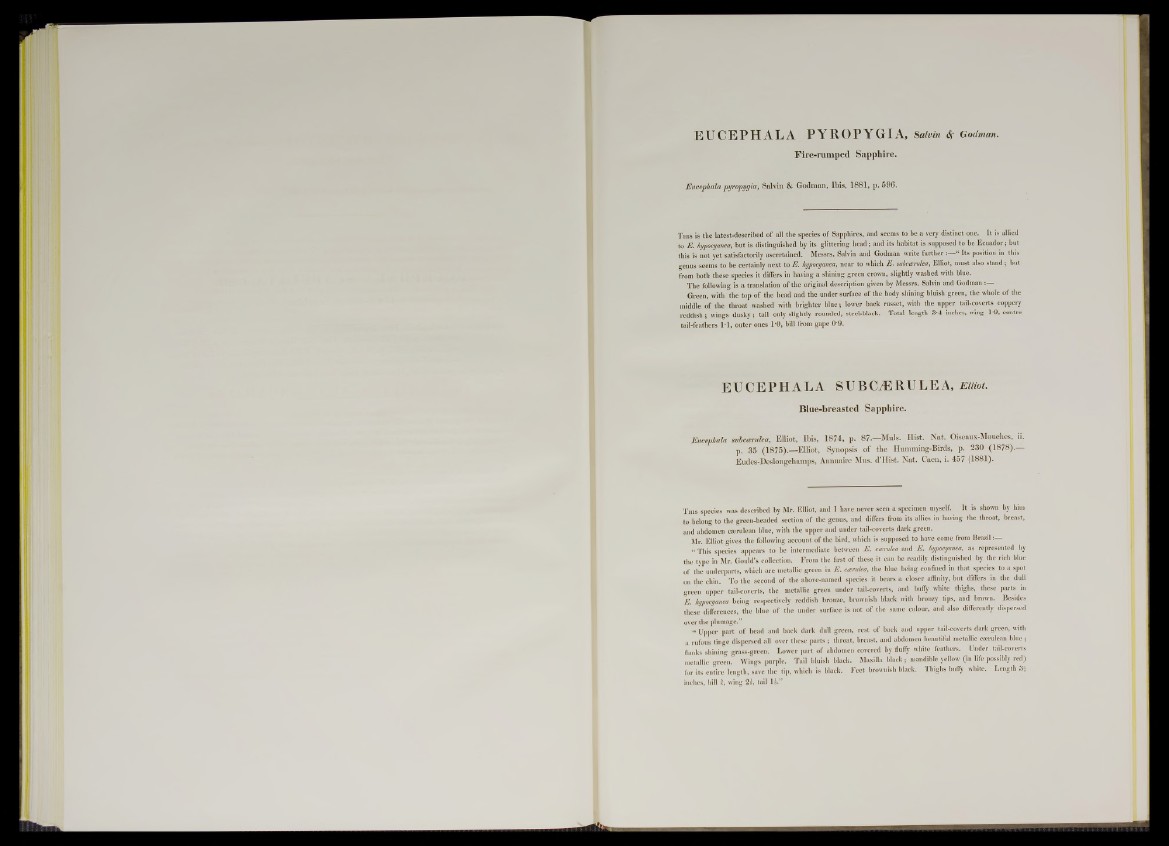
EUCEPHALA PYROPYGIA, Salvin S>' G oilman.
Fire-rumped Sapphire.
Eucephala p y ro p yg ia , Salvin & Goilinan, Ibis, 1 8 8 1 , p. 5 9 6 .
T his is the latest-described o f all the species o f Sapphires, and seems to be a very distinct one. It is allied
to E. hypocyanea, bnt is distinguished by its glittering head; and its habitat is supposed to he Ecuador; hut
this is not yet satisfactorily ascertained. Messrs. Salvin and Godman write f u r t h e r “ Its position in this
genus seems to be certainly next to E. hypocyanea, near to which E . subccerulea, Elliot, must also stand; hut
from both these species it differs in having a shining green crown, slightly washed with blue.
The following is a translation o f the original description given by Messrs. Salvin and Godman K S B
Green, with the top of the head and the under surface of the body shining bluish green, the whole of the
middle o f the throat washed with brighter blue; lower back russet, with the upper tail-coverts coppery
reddish; wings dusky; tail only slightly rounded, steel-black. Total length 3-4 inches, wing 1-9, centre
tail-feathers IT , outer ones TO, bill from gape 0 ’9.
EUCEPHALA SUBCÆRULEA, Elliot.
Blue-breasted Sapphire.
Eucephala m b cæ n d ea , Ellio t, Ibis, 1 8 7 4 , p. 8 7 .— Muls. H ist. N a t. Oiseaux-Mouches, ii.
p. 3 5 (1 8 7 5 ) .— E llio t, Synopsis o f th e Humming-Birds, p. 2 3 0 (1 8 7 8 ) .—
Eu des-Deslongchamps, Annuaire Mus. d’H ist. Na t. Caen, i. 4 5 7 (1 8 8 1 ).
T his species was described by Mr. Elliot, and I have never seen a specimen myself. It is shown by him
to belong to the green-headed section o f the genus, and differs from its allies in having the throat, breast,
and abdomen cterulean blue, with the upper and under tail-coverts dark green.
Mr. Elliot gives the following account o f the bird, which is supposed to have come from Brazil
1 This species appears to be intermediate between E . camlea and E . hypocyanea. as represented by
the type in Mr. Gould’s collection. From the first of these it can be readily distinguished by the rich blue
of the underparts, which are metallic green in E . carulea, the blue being confined in that species to a spot
on the chin. To the second o f the above-named s p e c ie s b e a r s a closer affinity, but differs in the dull
green upper tail-coverts, the metallic green under tail-coverts, and huffy white thighs, these parts in
E. hypocyanea being respectively reddish bronze, brownish black with bronzy tips, and browu. Besides
these differences, the blue o f the under surface is not o f the same colour, and also differently dispersed
over the plumage.”
“ Upper part o f head and back dark dull green, rest of back and npper tail-coverts dark green, with
a rufous tinge dispersed all over these parts ; throat, breast, and abdomen beautiful metallic cterulean blue;
flanks shining grass-green. Lower part o f abdomen covered by fluffy white feathers. Under tail-coverts
metallic green. Wings purple. Tail bluish black. Maxilla black; mandible yellow (in life possibly red)
for its entire length, save the tip, which is black. Feet brownish black. Thighs huffy white. Length 31